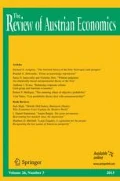Abstract
Insecure linkage of ordinary money to fractional reserves of a distinct base money can sometimes endanger the smooth working of modern monetary systems. This danger applies most obviously to the analogous insecure pegging of domestic to foreign currency. Worry would better focus, however, not on the size of reserve ratios but on the very existence of something distinct to which ordinary money is linked.
In the modern world money is a device for monitoring transactions, keeping records, calculating economic benefits and costs, and accomplishing multilateral clearing. Money enables people conveniently to use the entitlements acquired by delivering goods and services and securities to some trading partners to obtain others of these from other trading partners. The tickets and memoranda employed in these operations need not take the form of little disks of precious metal or even of certificates convertible into them or some other kind of ultimate base money.
It would be economically advantageous and feasible to make all money “inside money” (in the sense of Gurley and Shaw), with the value of the money unit determined and maintained otherwise than through convertibility into a distinct base money, which would have been abolished.
Similar content being viewed by others
References
Allais, M. (1947) Économie et Intérêt. Two volumes. Paris: Imprimerie Nationale.
Cohen, M. R. and Nagel, E. (1934) An Introduction to Logic and Scientific Method. New York: Harcourt, Brace.
Davenport, H. J. (1913) The Economics of Enterprise. New York: Macmillan. (1968) Reprinted New York: Kelley.
Diamond, D. W. and Dybvig, P. H. (1983) “Bank Runs, Deposit Insurance, and Liquidity.” Journal of Political Economy, 91: 401-419.
Dowd, K. (1991) “Financial Instability in a ‘Directly Convertible’ Gold Standard.” Southern Economic Journal, 57: 719-726.
Dowd, K. (1996) Competition and Finance: A Reinterpretation of Financial and Monetary Economics. New York: St. Martin's Press.
Fischer, D. H. (1970) Historians' Fallacies. New York: Harper Torchbooks.
Friedman, M. (1969) “The Optimum Quantity of Money.” In The Optimum Quantity of Money and Other Essays. Chicago: Aldine.
Goodfriend, M. (1991) “Money, Credit, Banking, and Payments System Policy.” Federal Reserve Bank of Richmond. Economic Review, 77: 7-23.
Gurley, J. G. and Shaw, E. S. (1960) Money in a Theory of Finance. Washington: Brookings Institution.
Hawtrey, R. G., (1913) Good and Bad Trade. London: Constable. (1970) Reprinted New York: Kelley.
Hoppe, H.-H. (1994) “How is Fiat Money Possible?—or, The Devolution of Money and Credit.” Reviewof Austrian Economics, 7(2): 49-74.
Hoppe, H.-H., Hülsmann, J. G. and Block, W. (1998) “Against Fiduciary Media.” Quarterly Journal of Austrian Economics, 1(1): 19-50.
Huerta de Soto, J. (1998a) Dinero, Crédito Bancario y Ciclos Económicos. Madrid: Unión Editorial.
Huerta de Soto, J. (1998b) “A Critical Note on Fractional-Reserve Free Banking.” Quarterly Journal of Austrian Economics, 1: 25-49.
Hülsmann, J. G. (1996a) Logik der Währungskonkurrenz. Essen: Akademie Verlags-und Druck-Gesellschaft.
Hüulsmann, J. G. (1996b) “Free Banking and the Free Bankers.” Review of Austrian Economics, 9(1): 3-53.
Kocherlakota, N. R. (1998) “The Technological Role of Fiat Money.” Federal Reserve Bank of Minneapolis. Quarterly Review, 22(3): 2-10.
Kuenne, R. E. (1958) “On the Existence and Role of Money in a Stationary System.” Southern Economic Journal, 25: 1-10.
Leijonhufvud, A. (1987) “Rational Expectations and Monetary Institutions.” In: de Cecco, M., and Fitoussi, J.-P. (Eds.) Monetary Theory and Economic Institutions, pp. 44-65. Houndmills: Macmillan.
Menger, C. [1950 (1871)] Principles of Economics. Translated by Dingwall, J. and Hoselitz, B. F. Glencoe: Free Press.
Menger, C. (1892) “On the Origin of Money.” Economic Journal, 2: 239-255.
Menger, C. [1970 (1892, 1909)] “Geld.” Reprinted in Gesammelte Werke, IV: 1-116. Tübingen: Mohr (Siebeck).
Moini, M. (1999) “Toward a General Theory of Credit and Money.” Presented at the Austrian Scholars Conference, Auburn, Alabama, 17 April 1999.
Patinkin, D. (1956, 1965) Money, Interest, and Prices. First and second editions. New York: Harper & Row.
Rand, A. (1957) Atlas Shrugged. New York: Random House. Reprinted as a paperback Signet Book by New American Library.
Schumpeter, J. A. (1956) “Money and the Social Product.” In: Henderson, E. and others (Eds.) International Economic Papers, Vol. 6, pp. 148-211. London: Macmillan. Translated by Marget, A. W. from “DasSozialprodukt und die Rechenpfennige. Glossen und Beiträge zur Geldtheorie von heute.” Archiv fÜr Sozialwissenschaft und Sozialpolitik, 44: 1917-18. Reprinted in Schumpeter, Aufsätze zurökonomischen Theorie,Tübingen, 1952.
Schumpeter, J. A. (1970) Das Wesen des Geldes. Edited from manuscript (mostly drafted by around 1930) and with an introduction by Fritz Karl Mann. Göttingen: Vandenhoeck & Ruprecht.
Selgin, G. A. (1988) The Theory of Free Banking. Totowa, NJ: Rowman & Littlefield.
Selgin, G., and Lawrence, H. W. (1996) “In Defense of Fiduciary Media—or, We are Not Devo(lutionists), We are Misesians!” Review of Austrian Economics, 9(2): 83-107.
Shah, P. J. and Yeager, L. B. (1994) “Schumpeter on Monetary Determinacy.” History of Political Economy, 26: 443-464.
Tobin, J. (1965) “Money and Economic Growth.” Econometrica, 33: 671-684.
Velasco, A., and Chang, R. (1998) “The Asian Liquidity Crisis.” C. V. Starr Center for Applied Economics, New York University, Research Report 98-27.
Woolsey, W. W. and Yeager, L. B. (1994) “Is There a Paradox of Indirect Convertibility?” Southern Economic Journal, 61: 85-95.
Yeager, L. B. (1989) “A Competitive Payments System: Some Objections Considered.” Journal of Post Keynesian Economics, 11: 370-377.
Yeager, L. B. (1997) The Fluttering Veil. Selgin, G. (Ed.), Indianapolis: Liberty Fund.
Rights and permissions
About this article
Cite this article
Yeager, L.B. The Perils of Base Money. The Review of Austrian Economics 14, 251–266 (2001). https://doi.org/10.1023/A:1011981013028
Issue Date:
DOI: https://doi.org/10.1023/A:1011981013028




